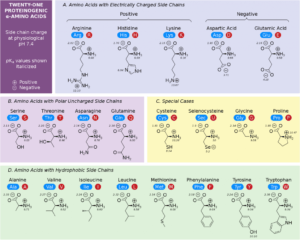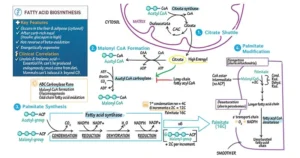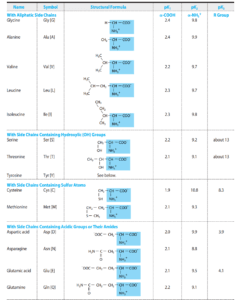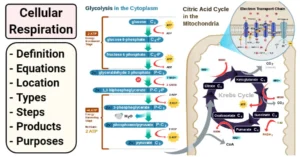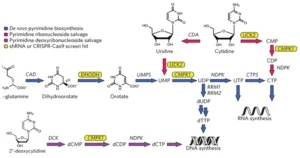Amino acids are the building blocks of proteins, each with unique properties that contribute to their various roles in biological processes. Here, we explore each amino acid, highlighting its properties, functions, roles, and applications.
Properties of Amino Acids
- Basic Structure:
- Central carbon atom (α-carbon)
- Amino group (—NH₂)
- Carboxyl group (—COOH)
- Hydrogen atom
- R-group (side chain) that varies for each amino acid
- Classification:
- Nonpolar (Hydrophobic): Alanine, Valine, Leucine, Isoleucine, Methionine, Phenylalanine, Tryptophan, Proline
- Polar (Hydrophilic): Serine, Threonine, Cysteine, Tyrosine, Asparagine, Glutamine
- Acidic: Aspartic acid, Glutamic acid
- Basic: Lysine, Arginine, Histidine
- Essential vs. Non-Essential:
- Essential Amino Acids: Must be obtained from the diet (e.g., leucine, isoleucine, valine).
- Non-Essential Amino Acids: Can be synthesized by the body (e.g., alanine, aspartic acid).
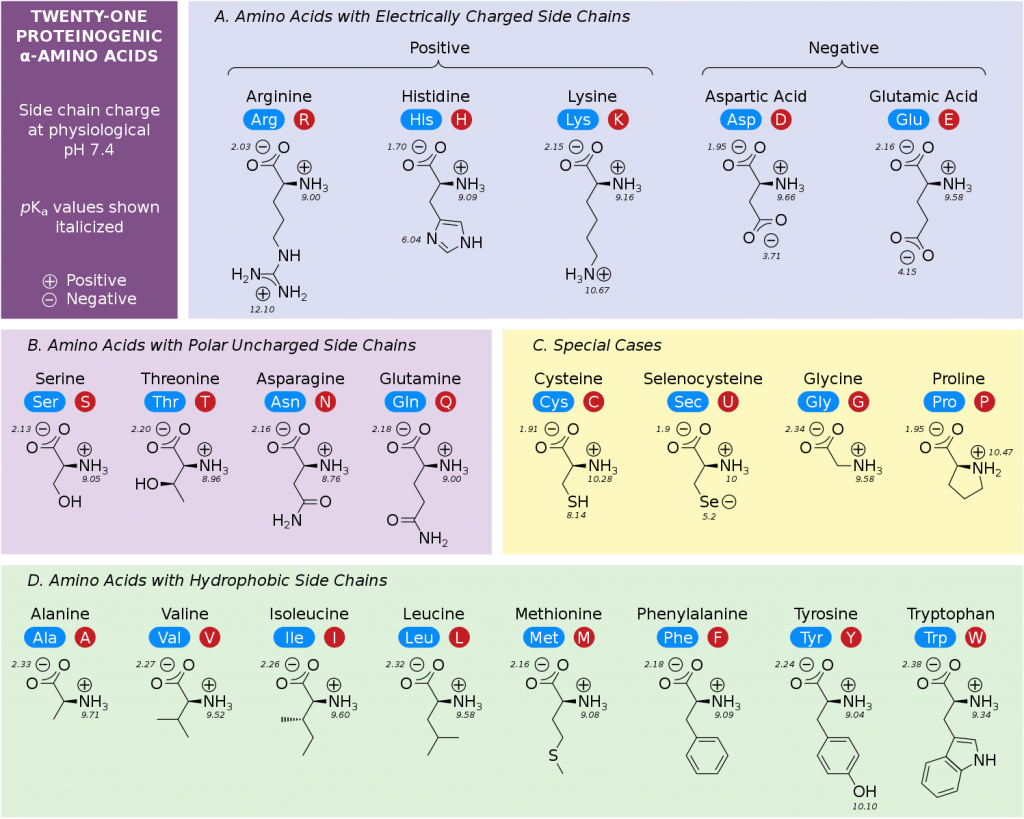
Essential Amino Acids
These amino acids cannot be synthesized by the human body and must be obtained from the diet.
- Histidine
- Isoleucine
- Leucine
- Lysine
- Methionine
- Phenylalanine
- Threonine
- Tryptophan
- Valine
Non-Essential Amino Acids
These amino acids can be synthesized by the human body.
- Alanine
- Arginine (semi-essential, required in larger amounts during periods of growth)
- Asparagine
- Aspartic acid
- Cysteine (conditionally essential, especially for infants and elderly)
- Glutamic acid
- Glutamine (conditionally essential during illness or injury)
- Glycine
- Proline
- Serine
- Tyrosine (derived from phenylalanine)
Conditionally Essential Amino Acids
Under certain conditions, such as illness or stress, some non-essential amino acids become essential because the body’s requirements exceed its ability to produce them.
- Arginine
- Cysteine
- Glutamine
- Tyrosine
- Glycine
- Proline
- Serine
This classification highlights the importance of dietary intake for essential amino acids and the body’s capability to synthesize non-essential amino acids under normal conditions.
Functions and Roles of Amino Acids
- Protein Synthesis:
- Amino acids are the monomers that polymerize to form proteins, which are essential for the structure, function, and regulation of the body’s tissues and organs.
- Enzyme Catalysis:
- Many enzymes, which catalyze biochemical reactions, are proteins composed of amino acids.
- Metabolism:
- Amino acids play key roles in metabolic pathways. For example, they are involved in the Krebs cycle and the urea cycle.
- Signaling Molecules:
- Some amino acids function as neurotransmitters (e.g., glutamate, glycine) or as precursors for other signaling molecules (e.g., tryptophan is a precursor for serotonin).
- Regulation of Gene Expression:
- Amino acids can influence gene expression by modifying the availability of transcription factors and other regulatory proteins.
Applications of Amino Acids
- Medical and Therapeutic Uses:
- Nutritional Supplements: Essential amino acids are used in supplements to ensure adequate intake.
- Medical Treatments: Amino acids are used in parenteral nutrition, wound healing, and managing certain metabolic disorders.
- Pharmaceuticals: Amino acid derivatives are used in drugs (e.g., L-dopa for Parkinson’s disease).
- Food and Agriculture:
- Food Industry: Amino acids like glutamate are used as flavor enhancers (e.g., MSG).
- Animal Feed: Amino acids are added to animal feed to ensure balanced nutrition and promote growth.
- Biotechnology:
- Bioproduction: Amino acids are used in the production of enzymes, hormones, and other bioactive compounds through fermentation and other biotechnological processes.
- Cosmetics:
- Skincare Products: Amino acids are included in cosmetics for their moisturizing and anti-aging properties.
Summary of Key Amino Acids and Their Roles
- Glycine: Simplest amino acid, involved in collagen synthesis and as an inhibitory neurotransmitter.
- Alanine: Important in glucose-alanine cycle for energy production.
- Valine, Leucine, Isoleucine: Branched-chain amino acids (BCAAs), critical for muscle protein synthesis and repair.
- Phenylalanine: Precursor for neurotransmitters like dopamine and norepinephrine.
- Tryptophan: Precursor for serotonin and melatonin, involved in mood regulation and sleep.
- Cysteine: Contains sulfur, important for disulfide bonds in proteins, antioxidant properties.
- Methionine: Essential for methylation processes and the synthesis of S-adenosylmethionine (SAMe).
Amino Acids
Amino acids are indispensable to life, serving as the building blocks of proteins and playing numerous roles in metabolism, signaling, and overall physiological function. Their diverse applications span medical, nutritional, agricultural, and industrial fields, highlighting their importance in both health and technology.
1. Alanine
Properties: Nonpolar, hydrophobic
Functions: Involved in glucose metabolism and energy production
Role: Participates in the glucose-alanine cycle, transferring nitrogen from muscle to liver
Applications: Used in sports nutrition for energy and performance enhancement
2. Arginine
Properties: Basic, polar, positively charged
Functions: Precursor for nitric oxide, crucial for blood flow regulation
Role: Plays a role in cell division, wound healing, and immune function
Applications: Used in supplements to enhance cardiovascular health and athletic performance
3. Asparagine
Properties: Polar, uncharged
Functions: Involved in the synthesis of glycoproteins
Role: Important for the functioning of the nervous system
Applications: Used in cell culture media for the growth of cells in research and industry
4. Aspartic Acid
Properties: Acidic, polar, negatively charged
Functions: Participates in the citric acid cycle
Role: Important for the synthesis of other amino acids and nucleotides
Applications: Used in the food industry as a flavor enhancer
5. Cysteine
Properties: Polar, contains sulfur
Functions: Forms disulfide bonds, contributing to protein structure
Role: Acts as an antioxidant and is involved in detoxification
Applications: Used in cosmetics for its antioxidant properties and in pharmaceuticals for its role in detoxification
6. Glutamic Acid
Properties: Acidic, polar, negatively charged
Functions: Acts as a neurotransmitter in the central nervous system
Role: Involved in synaptic transmission and plasticity
Applications: Used as a flavor enhancer (MSG) in the food industry
7. Glutamine
Properties: Polar, uncharged
Functions: Serves as a nitrogen donor in various biosynthetic processes
Role: Critical for immune function and intestinal health
Applications: Used in supplements for muscle recovery and immune support
8. Glycine
Properties: Nonpolar, hydrophobic
Functions: Acts as an inhibitory neurotransmitter in the central nervous system
Role: Involved in collagen synthesis and central nervous system function
Applications: Used in pharmaceuticals and supplements for its calming effects
9. Histidine
Properties: Basic, polar, positively charged
Functions: Precursor to histamine, involved in immune response
Role: Important for growth, tissue repair, and production of blood cells
Applications: Used in treatments for rheumatoid arthritis and allergies
10. Isoleucine
Properties: Nonpolar, hydrophobic, branched-chain
Functions: Involved in muscle metabolism and immune function
Role: Important for energy production and hemoglobin synthesis
Applications: Used in sports nutrition to enhance muscle recovery and endurance
11. Leucine
Properties: Nonpolar, hydrophobic, branched-chain
Functions: Stimulates protein synthesis in muscles
Role: Essential for muscle repair and growth
Applications: Widely used in bodybuilding and athletic supplements
12. Lysine
Properties: Basic, polar, positively charged
Functions: Crucial for collagen formation and calcium absorption
Role: Important for protein synthesis and immune function
Applications: Used in dietary supplements to support immune health and prevent cold sores
13. Methionine
Properties: Nonpolar, contains sulfur
Functions: Involved in methylation processes and synthesis of S-adenosylmethionine (SAMe)
Role: Important for detoxification and metabolism
Applications: Used in pharmaceuticals for liver health and in animal feed to promote growth
14. Phenylalanine
Properties: Nonpolar, hydrophobic
Functions: Precursor for neurotransmitters like dopamine and norepinephrine
Role: Important for mood regulation and cognitive function
Applications: Used in dietary supplements to enhance mood and cognitive function
15. Proline
Properties: Nonpolar, hydrophobic
Functions: Important for collagen stability
Role: Involved in the structure and function of connective tissues
Applications: Used in skincare products for its role in collagen production
16. Serine
Properties: Polar, uncharged
Functions: Participates in the synthesis of purines and pyrimidines
Role: Important for cell membrane formation and metabolism
Applications: Used in cosmetics for its moisturizing properties
17. Threonine
Properties: Polar, uncharged
Functions: Involved in protein synthesis and immune function
Role: Important for the central nervous system and cardiovascular health
Applications: Used in dietary supplements for immune support and protein synthesis
18. Tryptophan
Properties: Nonpolar, hydrophobic
Functions: Precursor for serotonin and melatonin
Role: Important for mood regulation and sleep
Applications: Used in supplements to promote relaxation and improve sleep quality
19. Tyrosine
Properties: Polar, uncharged
Functions: Precursor for thyroid hormones and neurotransmitters
Role: Important for stress response and cognitive function
Applications: Used in dietary supplements to support cognitive function and reduce stress
20. Valine
Properties: Nonpolar, hydrophobic, branched-chain
Functions: Involved in muscle metabolism and energy production
Role: Essential for muscle growth and tissue repair
Applications: Widely used in sports nutrition for muscle recovery and energy

